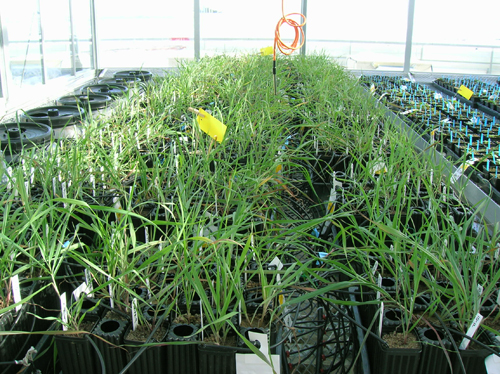
Purple loosestrife, St. John’s wort, garlic mustard: These and other invasive plants may be even more cunning than frustrated gardeners or farmers realize. And the secret to their creeping success, according to a new study by University of Guelph ecologists, may lie hidden beneath the soil surface.
Research by Mark Sherrard, a former PhD student, and Prof. Hafiz Maherali, Department of Integrative Biology, suggests that plants’ interaction with soil organisms can help sway the balance between invaders or native species. That’s no small concern for gardeners, farmers or land managers whose plants, crops and ecosystems face growing threats from invasive species.
In a paper published online in September in the journal Evolutionary Ecology, the U of G researchers suggest how invasive plants manipulate soil microbes to overcome native species on their home ground.
Many plants grow in relationships with soil organisms. Among the latter are fungi that live symbiotically, sharing resources such as water and nutrients with the plant roots. That relationship should help both the plants and the microbes, says Maherali.
Some researchers have suggested that those fungi “defend” their hosts by parasitizing foreign plants encroaching on their turf. “This would make maintaining native soil fungi an important conservation goal, because the microbes could be used to benefit native plants and exclude foreign invaders,” says Maherali.
But the story is more complicated.
For their study, the Guelph scientists looked at smooth brome grass. This species has invaded most of North America since being introduced from eastern Europe in the late 1800s. About a metre high, the plant has small yellow flowers and seeds that are easy to collect.

In 2008, the researchers collected grasses and soil from the U of G Arboretum and sites in Cambridge and Newmarket, Ont. They grew brome grass from each area in soil plots in the Science Complex greenhouse. They measured the amount of plant material or biomass that grew in each plot as well as the amounts of soil microbes.
The researchers found that fungi at a site parasitize invaders. But they also found that brome grass adapts to new sites by having evolved the ability to exclude those fungal defenders.
Says Maherali: “Even if we manage soil biota to exclude invaders, it is quite possible that the invaders will evolve to depend less on the fungi and successfully establish anyway. More generally, Mark’s research shows that we need to consider evolution in finding solutions to ecological problems.”
Sherrard says the study results might help ecologists with limited resources better manage invasive species. For instance, a land manager might have only enough money to tackle one of two interlopers. “Which plant species is more dependent on its fungal community?” he says. “The one with less dependence on fungi, moisture or nutrients is more likely to take and be successful. You want to eradicate that one first.”
He and his adviser were interested in learning more about how invasiveness works and how biotic factors help species adapt to an area. Other studies have suggested that invaders are better adapted to predators or that the invaders are fleeing some constraint in their old home.
“Our paper found that their ability to reduce their dependence on biotic factors allows them to spread,” says Sherrard.
Curious about the general role of soil organisms, they also grew all of the plants in plots of sterilized soil from all three locations. Effectively removing soil dwellers appeared to remove the home advantage, with local plants faring no better than foreign plants.
Says Sherrard: “Biotic factors play a big role. These findings suggest people might be misinterpreting factors driving adaptation.”
Most of these studies have focused on abiotic factors such as nutrients, water or temperature, ignoring the role of organisms such as fungi and bacteria.
If you’re seeding an area to manage or remediate it, he adds, “You might want to select seed adapted not just to abiotic but to biotic factors.”
Sherrard completed his PhD at Guelph in 2010 and now teaches biology at the University of Northern Iowa. He plans to continue related studies there, where farms have squeezed the original tall grass prairie to only about three per cent of the land mass.
Maherali says it’s important to know how certain plant traits have evolved and to be able to predict changes. That kind of information is useful in tackling invasive species and their effects on ecosystems, says the Guelph professor, currently on research leave at the National Evolutionary Synthesis Center in North Carolina. “If you’re doing ecological restoration and maintaining the habitat, the below-ground habitat could be important in resisting invasion.”